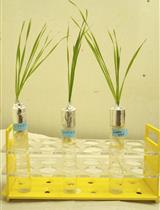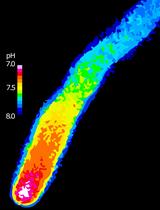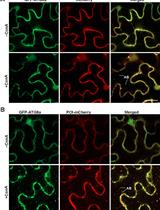- EN - English
- CN - 中文
ROS Detection in Botryococcus braunii Colonies with CellROX Green Reagent
使用CellROX绿色试剂检测布朗葡萄藻集落中的ROS
发布: 2017年08月20日第7卷第16期 DOI: 10.21769/BioProtoc.2508 浏览次数: 10086
评审: Maria SinetovaIgor Cesarino Anonymous reviewer(s)
Abstract
We analyzed the reactive oxygen species (ROS) accumulation in the colony-forming green microalga Botryococcus braunii in response to several stress inducers such as NaCl, NaHCO3, salicylic acid (SA), methyl jasmonate, and acetic acid. A staining assay using the fluorescent dye CellROX Green was used. CellROX Green is a fluorogenic probe used for measuring oxidative stress in live cells. The dye is weakly fluorescent inside cells in a reduced state but exhibits bright green photostable fluorescence upon oxidation by ROS and subsequent binding to DNA. The large amount of liquid hydrocarbons produced and excreted by B. braunii, creates a highly hydrophobic extracellular environment that makes difficult to study short times defense responses on this microalga. The procedure developed here allowed us to detect ROS in this microalga even within a short period of time (in minutes) after treatment of cells with different stress inducers.
Keywords: Botryococcus braunii (布朗葡萄藻)Background
Among the first methods developed to detect and quantify hydrogen peroxide and other organic hydroperoxides was the use of titanium (IV) ion (MacNevin and Urone, 1953). The yellow color resulted from the completion of titanium (IV) and peroxide molecules was detected by colorimetry. This method was used to detect endogenous peroxides, and to assay the catalase activity in two varieties of pear fruits for correlation with fruit ripening (Brennan and Frenkel, 1977). Another method to detect lipid hydroperoxides is based on thiobarbituric acid (TBA) and was used to measure the deterioration of foods such as milk (Sidwell et al., 1955). Although this method did not use organic solvents, steam distillation of an acidified slurry was necessary to detect hydroperoxides, and the resulting red color was quantified spectrophotometrically. The procedures described above have several disadvantages such as low sensitivity, interference with other compounds, and use of solvents or substances which may damage the living cells. A more sensitive method was developed in which the blue fluorescence of scopoletin (6-methyl-7-hydroxy-1:2-benzopyrone) disappeared after its oxidation by peroxidase enzyme (Andreae, 1955; Perschke and Broda, 1961). This method was used to detect the H2O2 production by NADPH in the microsomes from rat liver (Thurman et al., 1972). However, scopoletin is expensive, difficult to extract, and is an extremely toxic natural compound (Ojewole and Adesina, 1983a and 1983b). On the other hand, fluorescein is a dye chemically synthesized (Baeyer, 1871) and the chemical structure was elucidated (Markuszewski and Diehl, 1980). The fluorescence of both compounds, scopoletin and fluorescein, was then explained based on their similar chemical structure. So, further development of novel fluorescent dyes more stable and versatile allowed their use in very specific applications (Cathcart et al., 1983). For instance, 2,7-dichlorohydro-fluorescein diacetate (DCFH-DA) was used to study the intracellular production of active oxygen in the brown alga Fucus evanescens (Collén and Davison, 1997). The same compound DCFH-DA was also used to detect oxidative stress tolerance by abscisic acid (ABA) in the green microalga Chlamydomonas reinhardtii (Yoshida et al., 2003). Due to the wide application of these fluorescent dyes, private companies developed other compounds with different properties and each designed for specific applications. CellROX Green Reagent was designed to detect the production of ROS in living cells. So, we chose this dye to detect ROS in early times in B. braunii living cells (Life Technologies Corp., 2012). These reagents are cell-permeable and show no or very weak fluorescence in a reduced state, but their oxidation results in a strong fluorescence. In presence of ROS, the CellROX Green Reagent undergoes oxidation and produce green fluorescence followed by its binding to the DNA in the nucleus. This fact allows us to distinguish between the fluorescence resulting from ROS and the fluorescence from the chlorophyll molecule. Furthermore, this reagent can be fixed with formaldehyde and is compatible with some detergents. These characteristics of CellROX Green Reagent made it suitable to analyze ROS production in stress conditions in cells of the colonial microalga Botryococcus braunii race B (Nonomura, 1988; Banerjee et al., 2002).
Materials and Reagents
- Pipette tips 200 μl (Científica Senna, catalog number: 5-20236 )
- 96-well microplate polypropylene (Thermo Fischer Scientific, Thermo ScientificTM, catalog number: 267245 )
- Glass microscope slide (Corning, catalog number: 2947-75X25 )
- Coverslip (Corning, catalog number: 2890-22 )
Note: This product has been discontinued. - Aluminum foil (Reynolds Wrap 15 m x 30 cm)
- CellROX® Green Reagent (Thermo Fischer Scientific, InvitrogenTM, catalog number: C10444 , Excitation/Emission, 485/520 nm)
- Triton X-100 (Karal, catalog number: 9015 )
- Methyl jasmonate (abbreviated MeJA) (Sigma-Aldrich, catalog number: 392707-5ML )
- Potassium nitrate (KNO3) (Karal, catalog number: 5082 )
- Magnesium sulfate heptahydrate (MgSO4·7H2O) (Karal, catalog number: 6056 )
- Potassium phosphate dibasic (K2HPO4) (Karal, catalog number: 5080 )
- Calcium chloride dihydrate (CaCl2·2H2O) (Karal, catalog number: 2016 )
- Ethylenediaminetetraacetic acid ferric-sodium salt (Fe·Na·EDTA) (Sigma-Aldrich, catalog number: E6760-100G )
- Sulfuric acid (H2SO4) (Karal, catalog number: 1032 )
- Boric acid (H3BO4) (Karal, catalog number: 7021 )
- Manganese sulfate monohydrate (MnSO4·H2O) (Karal, catalog number: 1069 )
- Zinc sulfate monohydrate (ZnSO4·7H2O) (Karal, catalog number: 4089 )
- Cupric sulfate pentahydrate (CuSO4·5H2O) (Karal, catalog number: 8024 )
- Sodium molybdate dihydrate (NaMoO4·2H2O) (Karal, catalog number: 4072 )
- Cobalt(II) sulfate heptahydrate (CoSO4·7H2O) (Sigma-Aldrich, catalog number: 12933 )
Note: This product has been discontinued. - Sodium chloride (NaCl) (Karal, catalog number: 6052 )
- Potassium chloride (KCl) (Karal, catalog number: 5087 )
- Sodium bicarbonate (NaHCO3) (Karal, catalog number: 5010 )
- Sodium phosphate dibasic (Na2HPO4) (Karal, catalog number: 6005 )
- Modified CHU-13 media (see Recipes)
- 1x phosphate-buffered saline (PBS) (see Recipes)
Equipment
- 1.5 L flask (Corning, PYREX®, catalog number: 4980-1XL )
- Micropipettes (Mettler-Toledo International, Rainin®, catalog numbers: 17014392 , 17014382 and 17011790 )
- Incubator shaker (Select BioProducts, model: IncuMixTM Incubator Shaker, catalog number: SBS256 )
- Centrifuge (Labnet International, model: SpectrafugeTM 16M, catalog number: C0160 )
- Optical microscope (ZEISS, model: Axio Lab.A1 ) equipped with 470 nm LED module used for fluorochrome excitation and a set of 38 Endow GFP Filters (free exchange (E) EX BP 470/40, BS FT 495, EM BP 525/50) to detect the emission of the fluorochrome
- Digital camera (ZEISS, model: AxioCam ICc3 Rev.3 )
- pH meter (Cole-Parmer, Jenway, model: 3510 )
- Autoclave Sterilmatic (Market Forge Industries, model: STM-EL )
Software
- ZEN lite 2011 (ZEISS)
- GraphPad Prism version 6.00 for Mac OS X, GraphPad Software, La Jolla California USA (http://www.graphpad.com)
Procedure
文章信息
版权信息
© 2017 The Authors; exclusive licensee Bio-protocol LLC.
如何引用
Lozoya-Gloria, E., Cornejo-Corona, I., Thapa, H. R., Browne, D. R. and Devarenne, T. P. (2017). ROS Detection in Botryococcus braunii Colonies with CellROX Green Reagent. Bio-protocol 7(16): e2508. DOI: 10.21769/BioProtoc.2508.
分类
植物科学 > 藻类学 > 细胞分析
微生物学 > 微生物生理学 > 胁迫反应
细胞生物学 > 细胞成像 > 荧光
您对这篇实验方法有问题吗?
在此处发布您的问题,我们将邀请本文作者来回答。同时,我们会将您的问题发布到Bio-protocol Exchange,以便寻求社区成员的帮助。
Share
Bluesky
X
Copy link















